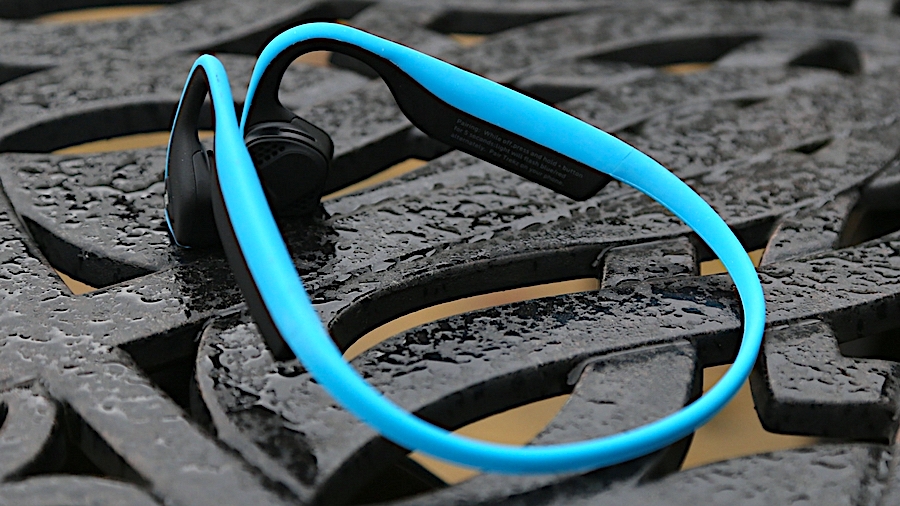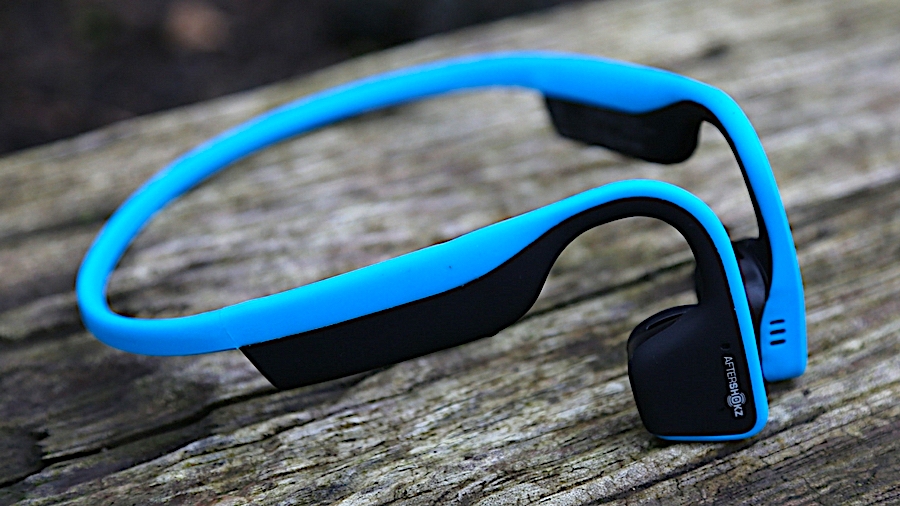TechRadar Verdict
With nothing in your ears, these near-ear bone conduction speakers offer a genuinely new way of listening to music. However, with a slight lack of comfort, clarity and volume, and bass that comes with vibrations, they don't consistently impress.
Pros
- +
Increased awareness
- +
Useful in gyms & offices
- +
Flexible, lightweight design
Cons
- -
Loose neck-strap
- -
Excessive vibrations
- -
Short battery life
- -
Some sound leakage
Why you can trust TechRadar
Music is all about immersion, but does that have to mean completely cutting-off the listener from the outside world? AfterShokz doesn’t think so, which is why its athlete-focussed Titanium open-ear sport headphones do the exact opposite.
However, the first thing to suffer when you put a headphone outside the ear is bass. So the Titanium are bone conduction headphones, essentially sending the vibrations from low-frequency sound into the top of the wearer’s cheekbones on their way to the cochlea in the inner ear, bypassing the eardrum.
Selling for £99.99 (US$129.95 , AU$149), the AfterShokz Titanium have just been superseded by a new, slimmer and pricer pair called the Trekz Air, which go for £149.99 (US$$149.95, AU$219).
Design
The AfterShokz Titanium’s design is impressive, with the two bone conduction transducers sitting just to the side of ears rather than going into the ear canal. In some ways they're similar to earcup-style headphones that send sound into the ear from outside, except that these don’t have any foam or covering to keep ambient noise out. One of the speakers has a pause button on the side, which proved really useful, and stops the wearer ever having to take them off.

We weren't especially concerned about the 36g weight of these sport-centric headphones, but we did have a small problem with the head-band, which is rather loose. We had to position it further up the back of our head than we were happy with, and in use in the gym they did move around a little too much.
That issue aside, the AfterShokz Titanium appears to have been carefully crafted, with the positioning of the transducers spot-on; they sat exactly at the top of our jawbone. They’re available in two-tone black and grey/blue/green/pink.
Performance
The AfterShokz Titanium may be primarily designed for the gym, and for jogs and runs outdoors, but we've zero interest in buying a different pair of headphones for every occasion. The AfterShokz Titanium needs to do it all, so we took them on a walk through a busy city centre.
There were moments of genuine epiphany where ‘situational awareness’ really impressed as a concept; entering a coffee shop and speaking to the barista without having to yank-off a pair of wired earphones was one. Another was walking through a bustling market and being able to hear what was going on around us. In some ways, wearing the AfterShokz Titanium felt genuinely liberating.
The reverse is also true; constant chatter in the coffee shop, and the constant din in the market, took us away from our music.

They may offer the best of times, the worst of times, but the AfterShokz Titanium do sound perfectly acceptable most of the time. It’s rather obvious that they’re at their best in quiet environments, and actually rather exciting to use around an office where it’s possible to listen to music while keeping one ear on colleagues’ chatter.
Crucially, the sound quality coming from those speakers don’t match a pair of regular headphones. The chief problem is bass. It’s not that they lack low frequency sound as such, but more that it’s felt more than heard – it reverberates through your jawbones. If this sounds weird then it should, because it also feels weird, if surprisingly easy to get used to.
However, if you push the volume beyond a certain point those vibrations get a bit too much, especially because they seem to dominate – the AfterShokz Titanium don’t actually go that loud. If you are in a busy, noisy place, it’s impossible to drown-out anything.

However, the AfterShokz Titanium are incredibly easy to use. Don’t forget that these are, at their most basic, a pair of wireless headphones. The initial Bluetooth set-up with a phone was easy, though the voice that confirms is a bit chatty. Does anyone really need to be politely welcomed to their headphones?
Controlling the AfterShokz Titanium is also a cinch, with one of the component boxes on the headband hosting volume buttons, one of which doubles as a long-press on/off switch. Next to that is a micro USB slot for recharging … and here comes a problem. At just six hours charge, the AfterShokz Titanium is immediately relegated from a pair of do-it-all headphones to a product that really should be thought of as single-activity, and that’s a shame. We realise ‘true wireless’ earphones have a worse problem, but that doesn’t make a six-hour battery acceptable.
We liked
Forget, for a moment, the AfterShokz Titanium’s bone conduction claims; being able to hear your surroundings while you listen to music makes this a genuinely interesting product. But is open-ear enough?
Lightweight and mostly comfortable to wear, the AfterShokz Titanium offers a very natural feel – you hardly know they’re there. As well as putting nothing into your ears, they offer sound quality that’s perfectly usable in quiet environments, and are particularly impressive around an office. They’re also both strong flexible, so easy to fit, and carry loose in a bag or pocket.

We disliked
Lacking clarity, the AfterShokz Titanium just don’t sound as good as ‘proper’ headphones. The bone conduction effect is one of bass, but at the high volumes necessary in busy city centres, or anywhere with strong winds, these strong vibrations are a little too much. We're also concerned about the short battery life, which at six hours makes them of limited use as everyday headphones.
Final verdict
The AfterShokz Titanium are fun to use, and around an office, they’re just great, allowing you to listen to things when you need to while also hearing conversations from colleagues. Perhaps their best feature is that it doesn’t feel like you’re wearing any headphones at all. However, when things get loud or you have to venture outside, the AfterShokz Titanium suffer from a lack of volume and too many vibrations.
Add a six-hour battery life and a rather loose neck-band that causes them to slip slightly when exercising, and the AfterShokz Titanium is left looking like a novelty product that needs some work. Happily, AfterShokz has just launched a slimmer, souped-up version, the AfterShokz Trekz Air; bone conduction technology may yet have something important to say about how we all listen to music.
Jamie is a freelance tech, travel and space journalist based in the UK. He’s been writing regularly for Techradar since it was launched in 2008 and also writes regularly for Forbes, The Telegraph, the South China Morning Post, Sky & Telescope and the Sky At Night magazine as well as other Future titles T3, Digital Camera World, All About Space and Space.com. He also edits two of his own websites, TravGear.com and WhenIsTheNextEclipse.com that reflect his obsession with travel gear and solar eclipse travel. He is the author of A Stargazing Program For Beginners (Springer, 2015),

